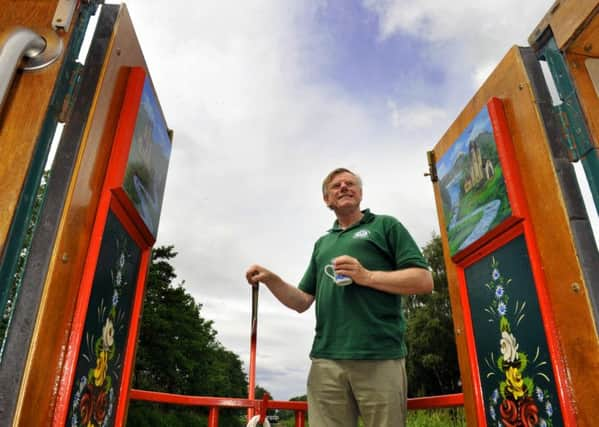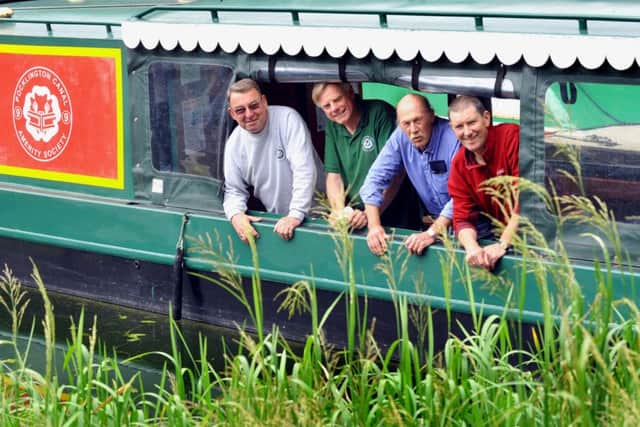Work, rest and ply, on the Pocklington Canal


“Well, the first time I came across it about eight years ago, the sun was shining and the birds were singing,” he says, suddenly all-nostalgic as he turns off a fairly minor road onto an extremely minor one. “The thing is that it’s in the middle of nowhere, it doesn’t go through any towns or villages... and it’s idyllic. Absolutely idyllic.”
Charlson is on the committee of the Pocklington Canal Amenity Society, a charity that campaigns to protect, restore and promote the 19th century canal, often described as “a hidden gem”.
Advertisement
Hide AdAdvertisement
Hide AdIt stretches lazily from East Cottingwith, between Selby and Market Weighton (but not really near either), to Canal Head, just short of Pocklington. Largely unaltered since it was built, it’s regarded as one of Britain’s most rural canals and also one of the most important for wildlife, with three sites of Special Scientific Interest.


The society’s 320 members are gearing up to celebrate the bicentenary of its 1818 opening and a hard core of them spend long hours doing repair work and, as I’m about to discover, enjoying themselves hugely.
These are good times for the Pocklington Canal. Back in April, the Canal and River Trust (formerly British Waterways), which owns it, was awarded a £496,000 Heritage Lottery Fund grant. This will allow, among other things, work on two bridges, environmental improvements and schemes to boost community involvement.
The society, formed in 1969, has also launched a £250,000 bicentenary appeal for repair and restoration work. It’s almost halfway there, thanks to donations, fetes and sales of merchandise (including some rather dinky mugs). And, between April and October, it offers trips on its narrowboat, New Horizons.
Advertisement
Hide AdAdvertisement
Hide AdWhich is why Charlson and I are heading through the uneventful, unspoiled countryside south-east of York, where contour lines are as unlikely as corncrakes. Together with three of his committee colleagues – Alistair Anderson, Bob Ellis and Richard Harker – he has turned out on an overcast summer afternoon to give me a taste of the trips, which attract up to 2,500 people a season.


On Sundays and Bank Holidays, there are regular half-hour trips (no booking required) plus, at other times, bookable trips of up to seven hours for real enthusiasts who can’t get enough of the middle of nowhere. No charges, but donations welcome.
New Horizons, painted bright and cheerful, is waiting at Melbourne Arm, a picturesque mooring at the midpoint of the canal. A dozen other boats are moored here between the yellow water lilies – boats with rather wistful names like Rainbow Carrier and Nutwood, Just Relax and Just Chillin’.
From here, thanks to the society’s restoration work, you can sail the five miles west to East Cottingwith. You can’t, as yet, sail east to Canal Head, though there are hopes of making the first two miles navigable by 2018 and eventually opening up the whole canal.
Advertisement
Hide AdAdvertisement
Hide AdBefore we board, a bit of history. The Pocklington, with its nine locks, was a late arrival on the canal scene. It was built to transport coal from West to East Yorkshire and farm produce the other way, but it never reached Pocklington. The journey had to be finished by horse and cart, so it started out with a major disadvantage.
The arrival soon afterwards of the more convenient railways sealed its fate. Then George Hudson, the “Railway King”, bought it in 1848 to eliminate potential competition for his trains and gradually ran it down.
“The last commercial use was in 1932,” says Charlson. “Then it gradually silted up and got choked with weeds and there was talk in the Fifties of filling it in with ‘inoffensive sludge’.”
Thankfully, that never happened, and over subsequent years, it evolved into a sort of secluded nature reserve, with oystercatchers, dragonflies, damselflies, aquatic plants... something interesting at every turn. Lovers of fan-leaved water crowfoot and narrow-leaved water plantain: this is the place for you. Barn owls hunt at dusk.
Advertisement
Hide AdAdvertisement
Hide AdAfter the ritual cutting of a large lunchtime pork pie, Richard Harker – wearing a hat labelled Ancient Mariner – switches on the engine, Bob Ellis casts off, startling a couple of moorhens, and off we go.
I’m invited to steer. Not a good idea for a non-driver, so I leave it to the experts and sit back and watch broad, low panoramas of faultless green landscape drift past at two mph. “It’s supposed to be the speed of a walking horse on a towpath,” explains Harker, as everyone eyes the last piece of pork pie.
With the engine purring, we pass bulrushes, bullfinches, flag iris, reeds, reed buntings, a couple of swans, swooping swallows, keening curlews, but – a slight disappointment – none of the kingfishers that can often be seen.
Britain’s canals offer a chance to travel in a slow, sometimes almost meditative way, to see the country from an alternative perspective. And here there’s no distraction from pure nature – hardly a house to be seen, no people, no sense that distant roads may lurk behind far-off copses.
Advertisement
Hide AdAdvertisement
Hide Ad“We’re a cul-de-sac,” says Ellis. “An old siding, if you like.” And the appeal to him? “This just relaxes me. You can forget everything; it’s a sense of well-being. People are generally gobsmacked by how quiet and peaceful it is.”
The four of them recall some memorable trips – a Women’s Institute group who brought picnics and their own tables; a Lions group who turned up in tuxedos carrying sides of salmon. We talk about windlasses, and Alistair Anderson and I study a map of the canal network and work out how I could get home from here to Sheffield on it (possible, but not recommended if you have deadlines to meet).
After a couple of miles, opening swing bridges as we go, we pull in at a lock. While the others prepare for the voyage back to the Melbourne Arm mooring, I go for a stroll along the grassy towpath, which runs the full length of the canal. There’s no sound except birdsong and rustling leaves. The sun comes out and dragonflies hover over marsh marigolds.
On the return trip, they bring out the visitors’ book. “Very big, goes slow,” writes young Daisy, astutely. “A cracking day out,” is an adult’s summing-up.
Advertisement
Hide AdAdvertisement
Hide AdAnd it has been. As we pull into the mooring, Charlson snatches up his binoculars. “There’s a kingfisher over there,” he says excitedly and, in a flash of iridescent blue, the bird disappears behind a tree.
Idyllic, like the man said. Absolutely idyllic.
pocklingtoncanalsociety.org